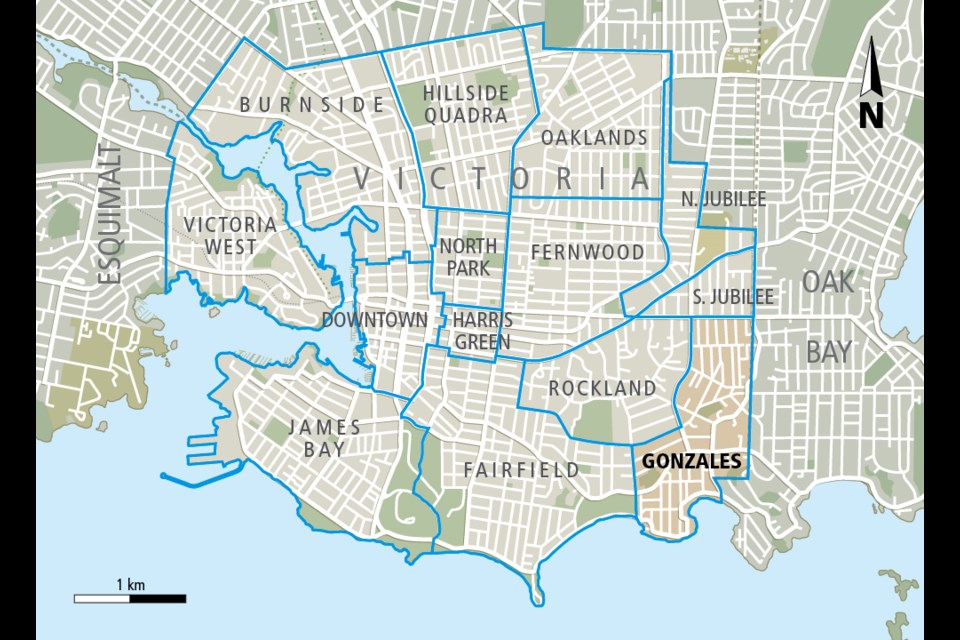Victoria’s plan to fast-track 10 new neighbourhood plans has hit a roadblock in Gonzales where city planners have met pushback over proposals to shape how the area will grow.
After two years of community meetings, workshops, surveys, draft plans, revisions, more drafts and more meetings, councillors have agreed to throw in the towel on the Gonzales neighbourhood plan, putting it indefinitely on hold.
Instead, the city will tackle such other neighbourhoods as Fernwood, North Park, Rockland, and North and South Jubilee.
“I think the neighbourhood is relieved and celebrating,” said Gonzales resident Michael Bloomfield, who has been opposed to the planning process from the outset.
“They tried to impose something on us through rather a devious process and people found time in their busy lives to rise up and say: ‘No, we just don’t want you to do this to our neighbourhood,’ ” Bloomfield said.
The process dates to 2015, when city council decided on a $700,000 “accelerated” program to, in the span of 3 1/2 years, update 10 neighbourhood plans bringing them in line with Victoria’s Official Community Plan. It’s a process that would normally take about 25 years.
Things started off well for city planners and two of the 10 updates, in Vic West and Burnside, were completed in quick order.
But that changed when they began working on the Fairfield/Gonzales update.
Coun. Chris Coleman, council liaison to the neighbourhood, said many of the objections were simply about accepting change. “People say they’re OK with density, but it’s change that they may have some difficulty with. When you boil it all down, we know we need more housing and a range of housing options but [the question is] how do you manage that?”
He notes the city’s Official Community Plan says Victoria will absorb 20,000 new residents over 25 years. Half are to be downtown, 8,000 in “villages,” and the balance via densification of residential neighbourhoods.
Bloomfield said Gonzales neighbourhood objections weren’t just about density but included aspects of proposals dealing with green space and tree canopy preservation, village areas and transportation routes.
Most frustrating, he said, was that for all the city “consultation,” it seemed no one was listening. “We would be promised modifications that were respectful to the community, and the next draft would come out and none of them would be in there and some new ones that set your hair on fire would have been added.”
Coun. Pam Madoff, for whom updated neighbourhood plans have long been a priority, said it is vital that city planners not only hear from residents but also listen to what they are saying.
Madoff said local area plans have to be about more than population numbers. “I think you have to understand the DNA of the neighbourhood and really listen to what people have to say as well.
“One of the things I’ve heard from a number of quarters is that the Official Community Plan, rather than being seen as a tool, is really being seen as a weapon,” she said, citing the northwest quadrant of Fairfield (between Cook and Vancouver streets up to Fort Street) as an example where zoning changes to allow greater height could tear apart a neighbourhood.
“And when you actually do an analysis of the number of units created in Fairfield, they’re exceeding the projections in the Official Community Plan on a yearly basis. So as they say, if it ain’t broke, why fix it? If you’re already getting these numbers without significant rezonings, why should we change to another model?” Madoff said.
Originally tackled as one large neighbourhood, Fairfield and Gonzales are now being treated separately with a newly formed Gonzales neighbourhood group.
Mayor Lisa Helps said there have been key lessons learned. “One is you can’t rush a neighbourhood plan and, two, neighbourhood plans are more than just about land use. They’re about public space. They’re about transportation.”
She points to “groundbreaking” work being done in Fairfield. “Fairfield is open to density and the best way to densify Fairfield … is to look at how can we use single-family lots better than we are right now, to put in triplexes and four-plexes and five-plexes that look and feel like single family homes but that can accommodate many more people.”
While Gonzales slips to the back of the queue, there’s now a neighbourhood group trying to find a consensus.
“They’re not throwing up their hands and saying we don’t want a plan. They’re saying move on and let us really dig into the issues here as a community,” Helps said.
Bloomfield, meanwhile, said the win in Gonzales means you can fight city hall. “I think it should be a lesson to our political leadership that if you engage people in a reasonable, honest process and put them first, you’re going to get a lot of constructive input.
“But if you try and basically put up a process as a masquerade to try to get approval for what you’ve already decided you’re going to do, people are going to object. And we did.”



